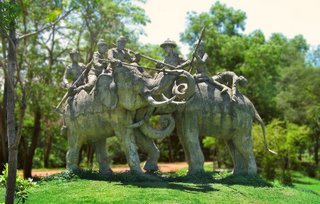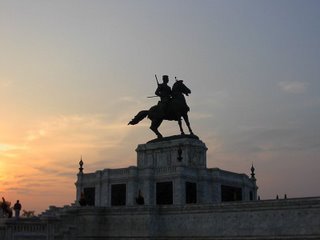Naresuan

A monument of King Naresuan in an elephant duel.
This article is about the Siamese king. For other uses, see Naresuan (disambiguation).
King Naresuan the Great (1555 - April 25, 1605 also sometimes called Naret or the Black Prince, Thai: สมเด็จพระนเรศวรมหาราช) was king of Siam (today Thailand) from 1590 until his death in 1605. During his reign, Siam had the biggest territorial extent in history.
Born in Phitsanulok, Naresuan was taken captive by the Burmese to ensure the fidelity of his father King Maha Thammaracha, who became king of the Ayutthaya kingdom after it was occupied by the Burmese in 1569. After spending nine years of his youth at Pegu under the protection of the Burmese king Bayinnaung (Thai language: Burinnaung, Burengnong) Naresuan was exchanged with his sister Princess Suphan Thewi when he was 16 years old, and became governor of Phitsanulok. He was highly trained by the Burmese king in martial arts, literature, military strategies and was one of the princes in the Burmese Palace.
In 1584, three years after Burmese King Bayinnaung's death in 1581, the tributary relation with Burma was cancelled, which was inevitably followed by a vigorous attack by the Burmese army. Naresuan fought back against the attack, and in 1586 he occupied Lanna, a buffer state between the two kingdoms.
1590 the king died, and Naresuan officially became the leader of the kingdom. In 1591 the Burmese started another attack, which was cancelled when the Burmese crown prince Minchit Sra was killed by Naresuan in personal combat on elephant back in Nong Sarai (Suphanburi). The following year Naresuan himself attacked Tenasserim, as well as Cambodia in 1593.
According to Prince Damrong's Our Wars with the Burmese, Naresuan died in 1605 during another battle with the Burmese, speared by Burmese soldiers as he attempted to climb over a garrison's wall in Tambon Thung Kaew, Mueang Hang. However, recent studies of Burmese records by historians of Silpakorn University showed that he actually returned to Wiang Haeng, where he died of disease, probably smallpox. His brother Ekathotsarot became his successor as king.
According to the Shan, Naresusuan helped them win independence for the Shan State in 1600 with his ally the Prince of Hsenwi. Both had been hostages at the Burmese court, and King Naresuan died while rushing to the aid of a friend of his youth, they say. Many Shan believe Naresuan was cremated and his ashes interred in a stupa in Mongton, in the southern part of the Shan State.


0 Comments:
Post a Comment
<< Home